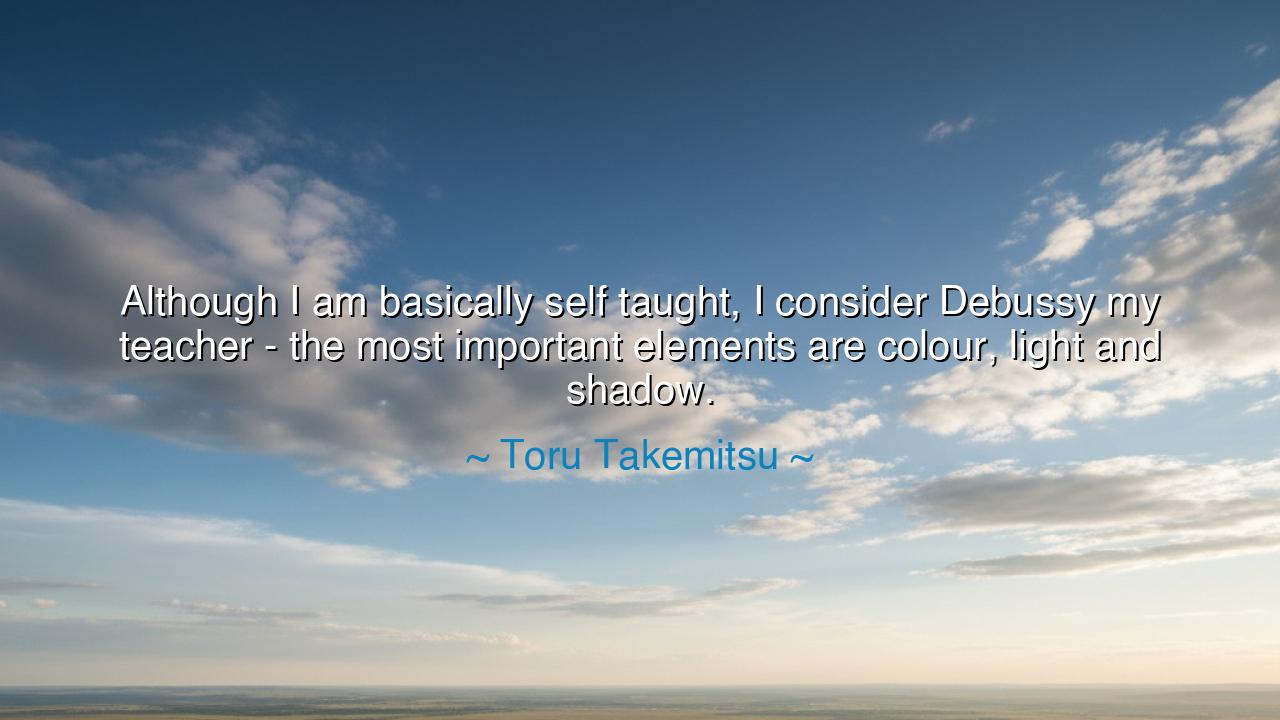
Although I am basically self taught, I consider Debussy my
Although I am basically self taught, I consider Debussy my teacher - the most important elements are colour, light and shadow.






Hear the words of Toru Takemitsu, poet of sound and master of silence, who declared: “Although I am basically self-taught, I consider Debussy my teacher – the most important elements are colour, light and shadow.” These words, spoken by a man who bridged East and West, tradition and modernity, carry the fragrance of ancient wisdom. For in them he reveals that the true teacher is not always met in the flesh, but may live in the spirit of another’s art. And he shows us that music—and indeed all creation—is not only sound, but painting, illumination, and the dance of darkness against brightness.
The first truth is in Takemitsu’s humility: “Although I am basically self-taught.” To be self-taught is to walk a lonely path, guided not by formal masters but by inner fire, curiosity, and struggle. Yet even the solitary student must look to the stars, and for Takemitsu, the brightest among them was Claude Debussy. Though separated by time, culture, and language, Debussy’s music spoke to him as a voice beyond the grave. Here lies a lesson: that the soul’s teachers are not always near at hand; they may be hidden in books, in art, in music, in the whispers of those who lived long before us.
Then he speaks of Debussy as his teacher. Why Debussy? Because Debussy taught not with rigid rules, but with freedom, with atmospheres, with subtleties. He turned away from the strict traditions of German harmony and embraced fluidity, impression, suggestion. Takemitsu found in Debussy a mirror of his own vision, for he too sought to dissolve barriers between East and West, between sound and silence, between music and nature. In Debussy’s colors, he found a palette to paint his own soul.
The heart of the saying lies in the elements: “colour, light and shadow.” These are not mere descriptions of music—they are the eternal elements of life itself. Colour is variety, richness, and the vibrancy of experience. Light is clarity, hope, revelation. Shadow is mystery, depth, the quiet strength of the unseen. Takemitsu teaches that great art, like life, must embrace all three. Music is not only brightness, nor only darkness; it is the interplay between them, just as the beauty of a landscape comes from the balance of sunlight and shade.
History offers us proof of this vision. When Takemitsu composed November Steps, combining Japanese instruments like the biwa and shakuhachi with Western orchestra, he painted in sound with colour, light, and shadow. Critics marveled at its strangeness, yet it became a bridge between worlds. It was not only music but philosophy, showing that opposites could coexist in beauty. Just as in nature, where dawn brings light but leaves behind shadow, so in music, harmony is born of contrast.
The lesson is clear: seek your teachers not only in flesh, but in spirit. Let the works of others—whether poets, painters, or composers—become your silent guides. Do not think you must imitate them, for Takemitsu did not become Debussy; he became himself, illuminated by Debussy’s light. And in your own work, in art or in life, embrace colour, light, and shadow. Do not chase only brightness, for life without shadow is flat; do not cling only to shadow, for life without light is despair.
Practical wisdom follows: when you create, when you live, ask yourself—Where is the colour in this? Where is the light? Where is the shadow? Allow contrasts to live together. Accept your struggles as shadows that give shape to your joy. Treasure your individuality, but also honour those teachers—seen or unseen—whose voices guide you. In this way, your life will not be a single flat note, but a tapestry, woven of brightness and depth.
Thus, remember always the words of Takemitsu: “Although I am basically self-taught, I consider Debussy my teacher – the most important elements are colour, light and shadow.” Let them remind you that creation is more than technique; it is painting with the soul. Let them guide you to seek wisdom in the past, to embrace harmony in contrast, and to live as both student and teacher, forever learning, forever illuminating, forever casting shadows that give shape to your light.






AAdministratorAdministrator
Welcome, honored guests. Please leave a comment, we will respond soon